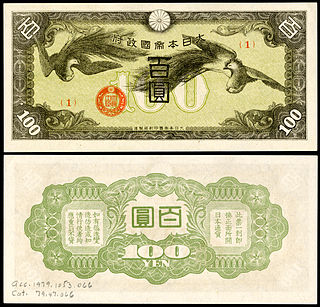See also
- Spanish silver dollar, used widely as currency in imperial China
- Chinese Yuán or RMB, sometimes informally referred to as "Chinese dollars"
- Hong Kong dollar
- History of Chinese currency
The Chinese dollar may refer to various historical currencies:

Tael, also known as the tahil and by other names, can refer to any one of several weight measures used in East and Southeast Asia. It usually refers to the Chinese tael, a part of the Chinese system of weights and currency. The Chinese tael was standardized to 50 grams in 1959.
The renminbi, also known as Chinese Yuan is the official currency of the People's Republic of China. The renminbi is issued by the People's Bank of China, the monetary authority of China. It is the world's fifth most traded currency as of April 2022.
The New Taiwan dollar is the official currency of the Republic of China. The New Taiwan dollar has been the currency of the island of Taiwan since 1949, when it replaced the old Taiwan dollar, at a rate of 40,000 old dollars per one new dollar. The base unit of the New Taiwan dollar is called a yuan (圓), subdivided into ten chiao (角) or 100 fen (分), although in practice neither chiao nor fen are ever actually used.

The Bank of Taiwan is a commercial bank headquartered in Taipei, Taiwan. It was the main issuer of banknotes on the island from 1899 to 1961, when that role was taken over by the Central Bank of China (now Central Bank of the Republic of China. The Bank of Taiwan is owned by the Government of the Republic of China.

Japanese military currency was money issued to the soldiers of the Imperial Japanese Armed Forces as a salary. The military yen reached its peak during the Pacific War period, when the Japanese government excessively issued it to all of its occupied territories. In Hong Kong, the military yen was forced upon the local population as the sole official currency of the territory. Since the military yen was not backed by gold, and did not have a specific place of issuance, the military yen could not be exchanged for the Japanese yen. Forcing local populations to use the military yen officially was one of the ways the Japanese government could dominate the local economies.
圓, 圆, 元, 円, or 원 may refer to:

The history of Chinese currency spans more than 3000 years. Currency of some type has been used in China since the Neolithic age which can be traced back to between 3000 and 4500 years ago. Cowry shells are believed to have been the earliest form of currency used in Central China, and were used during the Neolithic period.
The yuan is the base unit of a number of former and present-day currencies in Chinese.
Each "article" in this category is a collection of entries about several stamp issuers, presented in alphabetical order. The entries are formulated on the micro model and so provide summary information about all known issuers.
Yuan may refer to:
The Old Taiwan dollar was in use from 1946 to 1949, beginning shortly after Taiwan's handover from Japan to the Republic of China. The currency was issued by the Bank of Taiwan. Hyperinflation prompted the introduction of the New Taiwan dollar in June 1949, shortly before the Nationalist evacuation from mainland China in December.
Chinese cash may refer to:
A jiao, or mao, is a unit of currency used in Greater China, including the People's Republic of China, the Republic of China (Taiwan), Hong Kong and Macao. One jiao is equal to 1⁄10 of a yuan or 10 fēn (分).
The term Chinese currency may refer to:

Silver Dragon coins, also sometimes known as Dragon dollars, are silver coins issued by China, Japan and later Korea for general circulation in their own countries. Featuring a dragon on the obverse of Japanese and Korean issues and on the reverse of Chinese issues, all were inspired by the silver Spanish dollar which following its introduction into the region in the 16th Century had set the standard for a de facto common currency for trade in the Far East, this specification being a weight of 27.22 grams and a fineness of .900; the coin thus contained 24.5 g of silver.

The paper money of the Qing dynasty was periodically used alongside a bimetallic coinage system of copper-alloy cash coins and silver sycees; paper money was used during different periods of Chinese history under the Qing dynasty, having acquired experiences from the prior Song, Jin, Yuan, and Ming dynasties which adopted paper money but where uncontrolled printing led to hyperinflation. During the youngest days of the Qing dynasty paper money was used but this was quickly abolished as the government sought not to repeat history for a fourth time; however, under the reign of the Xianfeng Emperor, due to several large wars and rebellions, the Qing government was forced to issue paper money again.

The Zhuangpiao, alternatively known as Yinqianpiao, Huipiao, Pingtie (憑帖), Duitie (兌帖), Shangtie (上帖), Hupingtie (壺瓶帖), or Qitie (期帖) in different contexts, refer to privately produced paper money made in China during the Qing dynasty and early Republic of China periods issued by small private banks known as qianzhuang. Other than banknotes qianzhuang also issued Tiexian.

The Da-Qing Bank, also known as the Great Qing Bank, or previously Hubu Bank, was a state-controlled entity established by the Qing dynasty in 1905 to serve as Imperial China's first central bank. It issued banknotes that were intended to unify the Qing dynasty's currency system. In 1912 following the Xinhai Revolution, the Bank of China was created to take over the role of the Da-Qing Bank, which was liquidated in an orderly manner.

The banknotes of the Da-Qing Bank were intended to become the main form of paper money of the Qing dynasty following the bank's establishment in 1905. The Da-Qing Bank had branches throughout China and many of its branches outside of its headquarters in Beijing also issued banknotes.

The Chinese gold yuan was a legal tender currency of China between August 1948 and 1949. It was a method used by the Republic of China government to accumulate gold from its citizens in preparation to relocate to Taiwan. It circulated in the country under the effective control of the Government of the Republic of China known as Taiwan Province, R.O.C., which issued paper money on August 19, 1948. This currency was notorious for vicious inflation due to inadequate issuance preparation and failure to strictly enforce issuance limits. In the early days of the issuance of the Golden yuan, the government used executive actions to force the public to exchange gold, foreign currency for the new currency. The legal exchange rate was 0.22217 grams of gold per gold yuan but it could not be honored. The sharply depreciating Fabi currency was at the rate of one golden yuan of the yen to 3 million fabi yuan, and this rate was used for the compulsory collection of public gold, silver, and foreign currency. In particular, the economic losses suffered by the urban middle class were so great that the ROC government lost its original most important supporters and was one of the reasons why the ROC government failed so quickly in the Chinese Civil War.